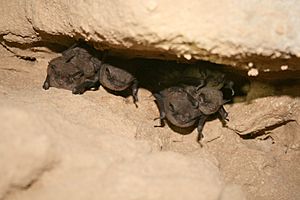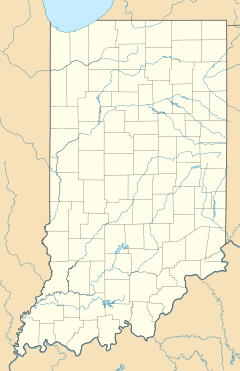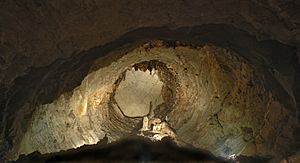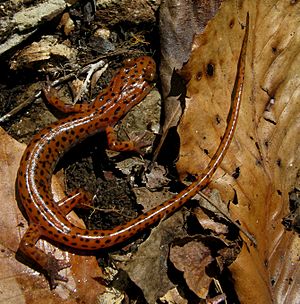Wyandotte Caves facts for kids
Quick facts for kids Wyandotte Caves |
|
|---|---|
| Historic Cave and Siberts Cave | |

An old photo of the entrance to Wyandotte Cave
|
|
| Location | Wyandotte Caves 7315 S Wyandotte Cave Rd Leavenworth, IN 47137 |
| Nearest city | Leavenworth |
| Designated: | 1972 |
The Wyandotte Caves are a pair of amazing limestone caves located near the Ohio River in Harrison–Crawford State Forest in Crawford County, Indiana. They are about 5 miles (8 km) northeast of Leavenworth and 12 miles (19 km) from Corydon.
In 1972, Wyandotte Caves were named a National Natural Landmark. Today, they are part of O'Bannon Woods State Park. This cave system is the fifth largest in Indiana and a popular place for visitors.
When people talk about "Wyandotte Caves," they usually mean two different caves: Wyandotte Cave (also called the "Historic Cave") and Little Wyandotte Cave (also known as Siberts Cave or the "New Cave"). Even though they are close and managed by the same group, they are quite different from each other.
Contents
How Wyandotte Caves Were Formed
Wyandotte Caves started forming about 2 million years ago during the Pliocene Era. Like many caves in Southern Indiana, they were created when water slowly dissolved limestone. This process carved out the hollow spaces we see today.
The limestone that makes up the ground in Southern Indiana, including where these caves are, was first laid down about 360 to 325 million years ago. Back then, Indiana was covered by a shallow inland sea.
Even though the giant ice sheets (glaciers) from the Pliocene and Pleistocene periods didn't quite reach Crawford County, where Wyandotte and Marengo Caves are, they greatly affected how these caves grew.
The Ohio River was also formed around this time. Today, it flows just minutes from Wyandotte Caves. As the glaciers melted, the cold water flowed towards the Ohio River. This water dissolved the limestone bedrock, helping to create caves like Wyandotte.
Amazing Cave Formations
The main entrance to Wyandotte Cave is about 220 feet (67 meters) above the Blue River. Wyandotte Cave is famous for its long, open tunnels and huge rooms. It has about 9.2 miles (14.8 km) of passages spread across five levels, making it the fifth longest cave in Indiana.
One of its most impressive features is Monument Mountain. Standing 135 feet (41 meters) tall, it's thought to be the world's largest underground mountain! Wyandotte Cave also has many rare helictites, which are unique cave formations that seem to defy gravity. The cave is also home to the tallest stalagmite in the world, called the Pillar of the Constitution. However, you can only see this on special crawling tours.
Siberts Cave has many long speleothems, which are cave formations made when rainwater dissolves calcium carbonate. You can see many different types of speleothems there, including:
- Stalactites (hanging from the ceiling)
- Stalagmites (growing from the floor)
- Columns (when stalactites and stalagmites meet)
- Flowstone (sheets of mineral deposits)
- "Cave bacon" (flowstone colored with iron oxide)
- "Cave draperies" (thin, wavy flowstone)
- Soda straws (thin, hollow stalactites)
- Popcorn (small, bumpy formations)
- Rimstone dams (small dams that hold water)
The temperature inside both caves stays at a cool 52°F (11°C) all year round.
History of Human Use in the Caves
Native Americans used Wyandotte Cave for almost 4,000 years before Europeans arrived. Evidence from artifacts suggests human activity might go back as far as 8000 BC. Native Americans used torches made of hickory bark and grape vines to light the cave. They mined for aragonite, which they used for pipes and necklaces, and chert, which they used to make stone tools. You can still see signs of their mining today on tours.
European settlers likely discovered Wyandotte Cave around 1798. Soon after, the cave became known as a great source of saltpeter, a key ingredient for gunpowder, and Epsom salts, which were used for medicine. Saltpeter mining in the cave was busiest during the War of 1812, led by a man named Dr. Benjamin Adams. Modern tours show Dr. Adams' old vats and hoppers. They also point out where magnesium sulfate (Epsom salt) sparkles on the cave walls. The cave was also used to store supplies for the army of William Henry Harrison.
Governor David Wallace named Wyandotte Cave after the river, which was then called the Wyandotte River (now known as the Blue River). Before its current name, it was called the Mammoth Cave of Indiana, the Epsom Salts Cave, and the Indiana Saltpetre Cave.
Henry Peter Rothrock bought the land above the caves in 1819. The Rothrock family didn't do much with the cave until 1850. That's when they started offering the first commercial tours after a large new section of the cave was found. This makes Wyandotte Cave the fourth oldest commercial cave in the United States. Siberts Cave was discovered in 1851 and named after its discoverer.
In 1966, the caves and 1,174 acres (4.75 km²) of woodland were sold to the Indiana Department of Natural Resources.
From 2009 to 2016, the caves were closed to visitors. This was to help slow the spread of white-nose syndrome, a disease affecting the bat population. After eight years, experts allowed the caves to reopen. Visitors now walk through "decontamination stations" at the end of each tour to help protect the bats. The long closure caused damage to the buildings on site, and many had to be taken down. State Representative Lloyd Arnold and Lieutenant Governor Eric Holcomb supported a $1.7 million project to rebuild the main building and fix the lights inside the cave. By 2018, the cave lights were repaired, and a temporary gatehouse was built.
Cave Tours
Little Wyandotte Cave Tours
Little Wyandotte Cave is completely separate from Big Wyandotte Cave. It has many beautiful flowstone and dripstone formations. The park offers a tour of this cave that is open to all ages and lasts 30–45 minutes. This tour does not have long stairways and is considered the easiest tour at Wyandotte Caves.
Big Wyandotte Cave Tours
A more challenging tour goes deep into Big Wyandotte Cave. This tour is about 2 hours long and covers 1.5 miles (2.4 km). Visitors can see rare formations like helictites, gypsum, epsomite, and ancient flint quarries. You can also see the famous "Monument Mountain" on this tour.
Animals Living in the Caves
Both Wyandotte Caves are home to more than 20 known animal species. These include bats, cave salamanders, crayfish, and crickets. Bones of larger animals have also been found in both caves.

Bats in the Caves
Indiana has 12 native species of bats. Wyandotte Cave is home to nine of these species, with a total bat population of over 30,000! The most common bat in the cave is the endangered Myotis sodalis. The Myotis lucifugus is also very common.
Little Wyandotte Cave rarely has bats. Its only entrance is less than 200 years old, and humans have been in that cave regularly since it opened. However, a brave bat might venture in sometimes.
The caves are closed to the public from November 1st to February 28th. This is mainly to protect the bats while they are hibernating in the winter. Lucky visitors might see bats during the rest of the year, but they are fewer and less likely to be disturbed in warmer months.
Salamanders in the Caves
You can often spot salamanders near the entrance of Wyandotte Cave and inside Little Wyandotte Cave.
Cave Fish
Blind cavefish are rarely seen in the larger Wyandotte Cave because it is very dry now. Little Wyandotte Cave is much wetter, but it still doesn't have any fish. The only living aquatic life found there are tiny bacteria.
Cave Crickets
Cave crickets are common in the smaller cave. Some occasionally enter the larger cave. They are sometimes eaten by snakes.
Gallery











